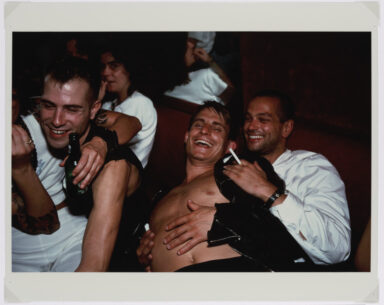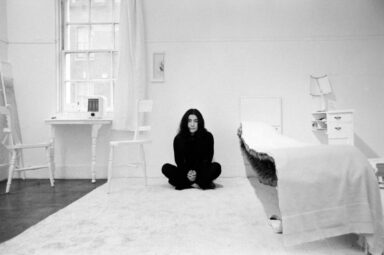Collectible DRY sat down with the feminist avant-garde artist to celebrate the opening of her latest group show — running at London’s Richard Saltoun Gallery until November 13 — and discuss the role of art in the post-pandemic scenario
Words by: Gilda Bruno
Collectible DRY: Focusing on the socio-political implications of what Hannah Arendt conceptualised as “The Crisis in Culture” in her book Between Past and Future (1961), this homonymous showcase features a selection of some of your drawings alongside sculptures and installations by fellow women artists Annette Messager and Pamela Rosenkranz. Inspired by your personal and artistic investigation of issues such as sexuality and eroticism, as well as by the interplay of masculine and feminine, the artworks on display alternate human subjects with abstract geometrical motifs used as allegories of the body.
How does your work explore the themes tackled in Hannah Arendt’s Between Past and Future (1961)? What aspects of your drawings could be seen as a direct reference and manifestation of the philosopher’s so-called ‘Crisis in Culture’? From your personal experience, in what ways would you say this crisis has manifested itself?
RB: The progressive loss of meaning of the traditional political catchphrases which are mentioned by Hannah Arendt — think of the notion of justice, reason, responsibility, virtue and fame — is a phenomenon that also applies to the art and culture community. Here, too, they have been and will be perverted, because discrimination, abuse of power, irresponsibility, immorality and lust for fame are the order of the day in the art world. We still live in a society characterised by patriarchal thinking and acting, a society where female knowledge and creativity are only very reluctantly and hesitantly included in vital global decisions. I perceive the current global situation as a threatening life crisis that requires total reorientation. Within this context, drawing has always been a particularly suitable medium for me to take up and explore seismographically current topics in a radical way. The human being reduced to their sexual organs becomes a helpless worm without arms or legs. They end up in a wheelchair, paralysed by fear, driven by their sexual impulses and crushed by the war between the sexes.

Renate Bertlmann, 1943 – The Bride II (Brecht “A Respectable Wedding”), 1973. Pencil, colour pencil, transparent paper backed with natural paper. 41 x 55 cm, framed 63 x 79 cm.
CD: What does art mean to you and what’s your take on Arendt’s conception of art as one of the main world-generating forces in history?
RB: As an artist, I have infinite freedom of creation. Freedom from which comes a great deal of responsibility. If I face the world bravely and have access to my “pregnant ground” — as I like to call it — then I will find artistic ideas that touch others. Art should seduce people into seeking and finding this place of freedom; a fertile territory where new creative answers can thrive and solve the existential questions of the world.
CD: The start of your artistic career dates back to the early 1970s, a moment that saw the birth of the women’s art movement, a new artistic current responsible for the shift in the worldwide representation (and perception) of the female universe and its numerous, up-until-then unexplored facets. How would you describe the vision of your artistic practice? And how has this evolved over time? What sort of factors — both personal and socio-cultural — have come to shape the evolution of your career as a feminist avant-garde artist?

Renate Bertlmann, Verwandlungen (Transformations), 1969/201353 black and white photographs 25 x 17 cm (each). Edition 1 of 3 plus 1 AP.
RB: Actively participating in the feminist movement of the 1970s, I realised that sexuality was and, unfortunately, still is the linchpin of women’s oppression. Everything that I became aware of in the form of the suppression and exclusion of female creativity and potency has naturally flowed into my work, which is why I also refer to my artistic work as a subversive political program. To this day, the themes of sexuality, pornography, eroticism, love, power and the complex relationships between the sexes are my most important artistic themes. AMO ERGO SUM, my credo, came about by itself as a summary of my life and my artistic work. For me, AMO ERGO SUM is the utopia of a whole person, in which body, mind, and soul are equal elements that interpenetrate and result in an indivisible whole. And with my knife and rose installation “DISCORDO ERGO SUM” (I disagree, therefore I am), which I developed for the Austrian Pavilion of the Venice Biennale 2019, I wanted to send a clear signal of my never-ending resistance.
CD: Drawing on Hannah Arendt’s conclusions on mass culture, consumerism, and art, as expressed in her publication Between Past and Future (1961), what do you think is the solution to the cultural crisis of modern times? Can art still serve as a vehicle for cultural change and socio-political renovation? If yes, how?
RB: Most people feel trapped in their living conditions, caught up in endless obligations and responsibilities. The “treasure” that Hannah Arendt speaks of, the treasure of inner and outer freedom, the possibility of reflecting on oneself, of going in search of oneself, is the key to a creative life. And artists have to go in search of this “treasure” and lift it, lift it again and again, even if the search is sometimes infinitely difficult and challenging.

Renate BERTLMANN 1943 – Boris lügt [Boris is Lying], 1974. Signed and dated ‘Renate Bertlmann 1974’ lower right. Pencil, gouache, and transparent paper laid on paper. 36 x 49 cm. Framed 60 x 72 cm.
CD: If already in 1961, Arendt looked at the rise of consumerism as a threat to people’s ability to interact with others as well as with their surroundings, to their system of values and creativity, the last couple of years have done nothing but further exacerbate everyone’s tendency to lean — either figuratively or concretely — towards an ever-increasing state of alienation. Complicit of such a phenomenon was the pandemic and the measures put in place to contain its spread.
What are your hopes for the future of the arts and culture world? How can artists divert people’s attention from the ephemeral, the materialistic, and the self-centered and redirect it to what is long-lasting, meaningful, and serving-a-wider-purpose? What purpose should art serve in 2021?
RB: The current crises show the fragility of the planet and its people, but also the ability and will of people for a new orientation, for a more mature coexistence. And when art is courageous and honest, and opens up to the challenges of life, it always carries transformative qualities within itself. Art can give hints on how we can courageously and creatively communicate with our environment, with people, and with life itself.

Taken from Deflorazione in 14 Stazioni (Defloration in 14 Stations), 1977. 15 Black and white photographs, vintage, one with scalpel.18 x 24 cm (each). Edition 1 of 4.
On Hannah Arendt: The Crisis in Culture is open until November 13 at Richard Saltoun Gallery, London, W1S 4NS





















